Speaker
Conor Fitzpatrick
(CERN)
Description
The current LHCb trigger system consists of a hardware level, which
reduces the LHC inelastic collision rate of 30 MHz to 1 MHz, at which the
entire detector is read out. In a second level, implemented in a farm of
20k parallel-processing CPUs, the event rate is reduced to about 5 kHz. The
major bottleneck in LHCb's trigger efficiencies for hadronic heavy
flavour decays is the hardware trigger. The LHCb experiment plans a
major upgrade of the detector and DAQ system in the LHC shutdown of
2018. In this upgrade, a purely software based trigger system is being developed, which
will have to process the full 30 MHz of inelastic collisions delivered by the LHC.
We demonstrate that the planned architecture will be able
to meet this challenge, particularly in the context of running
stability and long term reproducibility of the trigger decisions.
We discuss the use of disk space in the trigger farm to buffer events while
performing run-by-run detector calibrations, and the way this real time calibration and subsequent full event reconstruction
will allow LHCb to deploy offline quality multivariate selections from the earliest
stages of the trigger system. We discuss the cost-effectiveness of such a software-based approach with respect to alternatives relying on custom electronics. We discuss the particular importance of multivariate selections in the context of a signal-dominated production environment, and
report the expected efficiencies and signal yields per unit
luminosity in several key physics benchmarks the LHCb upgrade.
Authors
Conor Fitzpatrick
(CERN)
Gerhard Raven
(Natuurkundig Laboratorium-Vrije Universiteit (VU)-Unknown)
Johannes Albrecht
(Technische Universitaet Dortmund (DE))
Vladimir Gligorov
(CERN)
